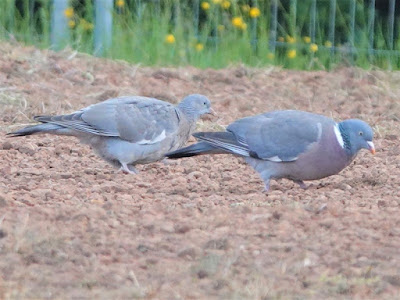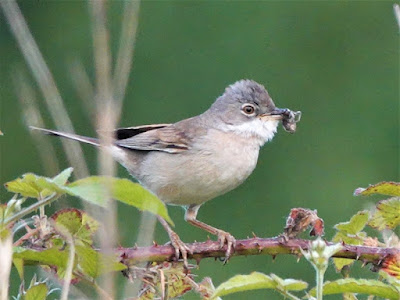Priorslee Lake and The Flash
12.0°C > 16.0°C: Broken medium cloud below scattered thin high cloud with watery sun at best. Moderate north-north-west wind. Very good visibility.
Sunrise: 04:57 BST
* = a photo of this species today
Priorslee Balancing Lake: 06:05 – 06:40 // 07:45 – 09:55
(111th visit of the year)
Bird notes:
- Two Common Whitethroats heard in song.
Birds noted flying over here:
- 2 Canada Geese: duo outbound
- 4 Wood Pigeons only
- 3 Lesser Black-backed Gulls
- 1 Cormorant
- 5 Jackdaws
Warblers noted (the number singing in brackets):
- 1 (1) Cetti's Warbler
- 2 (2) Willow Warblers
- 7 (6) Chiffchaffs
- 1 (1) Sedge Warbler
- 7 (6) Reed Warblers
- 12 (11) Blackcaps
- 1 (1) Garden Warbler
- 2 (2) Common Whitethroat
Hirundines etc., noted:
- 7 Swifts
- 1 Barn Swallow
Counts from the lake area: it remains very quiet
- 2 + 2 (1 brood) Mute Swans
- 5 (4♂) Mallard
- 4 Moorhens
- 28 + 15 (6 broods) Coots
- 6 Great Crested Grebes
- 1 Lesser Black-backed Gull: briefly
+ = my first sighting of this species this year.
++ = new species for me.
On the street lamp poles after dawn:
Nothing noted
Noted later: despite less wind and good sunshine the number and variety of insects seemed low.
Butterflies:
- none
Moths:
- Plain Gold (Micropterix calthella)
- +*Common Roller (Ancylis badiana)
- Silver-ground Carpet (Xanthorhoe montanata)
Bees / wasps etc.:
- *Tree Bumblebee (Bombus hypnorum)
- Early Bumblebee (Bombus pratorum)
- Common Wasp (Paravespula vulgaris)
Dragon-/damsel-flies:
- Azure Damselfly (Coenagrion puella)
- *Common Blue Damselfly (Enallagma cyathigerum)
- Blue-tailed Damselfly (Ischnura elegans)
- *Large Red Damselfly (Pyrrhosoma nymphula)
Hoverflies:
- Early or Late Buttercup Cheilosia [Cheilosia ranunculi (Early ...) or C. albitarsis (Late ...)]
- *Marmalade Hoverfly (Episyrphus balteatus)
- *Common Dronefly (Eristalis tenax)
- *Chequered Hoverfly (Melanostoma scalare)
- Syrphus sp. (S. ribesii / S. vitripennis)
Other flies:
- Scorpion Fly Panorpa sp.
- +*Muscid fly perhaps Helina abdominalis
- *Downlooker Snipefly (Rhagio scolopaceus)
- *dagger fly Empis tessellata
- several other unidentified fly sps.
Beetles:
- Alder Leaf Beetle (Agelastica alni)
- Raspberry Beetle (Byturus tomentosus)
- Lesser Thick-legged Flower Beetle (Ischnomera cyanea)
- Common Malachite Beetle (Malachius bipustulatus)
- *Nettle Weevil (Phyllobius pomaceus)
- *Common or Red-headed Cardinal Beetle (Pyrochroa serraticornis)
Bugs:
- Red-and-Black Froghopper (Cercopis vulnerata)
- *Dock Bug (Coreus marginatus)
Also
- White-lipped Snail (Cepaea hortensis)
- Nursery Web Spider (Pisaura mirabilis)
- stretch spider Tetragnatha sp.
- *first flowers of Early Marsh Orchid (Dactylorhiza incarnata)
Only two cygnets of the resident Mute Swans have survived. At last they seem to be growing.
A Stock Dove. Note there is no white on the neck, just an iridescent patch. Neither is there any white at the bend in the folded wing. Note the dark spots on wings.
In almost the same pose is an immature Wood Pigeon. No white on the neck of immatures but there is white around the bend of the folded wing. No dark spots on the wings.
Here is the same immature Wood Pigeon (on the left) with an adult.
Seems that Common Whitethroat is breeding here again this year after all. One bird had been singing continually and seemed to give up. Other birds were seen or heard only sporadically.
This one carrying food for youngsters. It managed to sing quietly while doing so.
A closer view of this attractive small moth. Its name derives from the caterpillars spinning a web in the rolled tip of a leaf.
The white tail distinguishes this as a Tree Bumblebee (Bombus hypnorum). Common Carder Bee (Bombus pascuorum), the other common bumblebee with a ginger thorax has a rufous tail.
A different and equally unkempt individual.
The thick stripes on the thorax are probably the easiest way to identify this as a male Common Blue Damselfly (Enallagma cyathigerum). The mark on segment two is also diagnostic but hard to see in the field. On Azure Damselfly (Coenagrion puella) the thorax markings are narrower and segment two has a 'U-shaped' dark mark.
Here is a female. These may be blue or green. When immature the colour is washed out, as in this blue specimen.
A Large Red Damselfly (Pyrrhosoma nymphula). For some reason I only find these in the hedge between Simon's garden and the footpath around the football field. So far I have only seen males - the female have black on most body segments.
Proving it is a hoverfly is this Marmalade Hoverfly (Episyrphus balteatus).
A close-up of a Common Dronefly (Eristalis tenax). The general shape is of this genus and the all-dark swollen hind tibia rules out other members of the genus.
Against the bright yellow of the buttercup the yellow markings of this Chequered Hoverfly (Melanostoma scalare) look rather faded. This is a female on which the yellow marks are triangular-shaped: on males they are rectangular.
"My what big eyes you have". This may be the Muscid fly Helina abdominalis. Then again....
A Downlooker Snipefly (Rhagio scolopaceus). With separated eyes this is a female.
This fly with the long proboscis is not a snipefly but a dagger fly and specifically Empis tessellata. It uses the proboscis to suck the insides out of its prey – charming! It does not attack man.
No idea about this interestingly marked fly. It flew away before I could reposition for a better shot.
"I'm coming to get you". A Nettle Weevil (Phyllobius pomaceus) advances.
A Common or Red-headed Cardinal Beetle (Pyrochroa serraticornis).
Another. On this the reason for serraticornis in its scientific name is more apparent.
My first Dock Bug (Coreus marginatus) for awhile.
I think this is an Early Marsh Orchid (Dactylorhiza incarnata). I get very confused with the first orchids that appear, trying decide whether they are this species or Southern Marsh Orchid (D. praetermissa). Seems I am not the only one as the species are known to hybridise.
(Ed Wilson)
------------------------------------------------------------------------------------------------------
The Flash: 06:45 – 07:40
(102nd visit of the year)
Bird notes:
- Apart from my first juvenile Moorhens here it was quiet. [the Moorhens on both the pools between the lake and The Flash have had juveniles for several weeks.]
Birds noted flying over here:
None
Warblers noted (the number singing in brackets):
- 4 (4) Chiffchaffs
- 3 (3) Blackcaps
Hirundines etc., noted:
- 3 Swifts
Noted on / around the water
- 27 Canada Geese
- no Greylag Geese
- 3 + 7 Mute Swans
- 16 (14♂) Mallard
- 1 (1♂) all-white duck (Peking(?) Duck)
- 3 (2♂) Tufted Duck
- 4 + 1 (1 brood) Moorhens
- 22+ 4 (2 broods) Coots
- 3 Great Crested Grebes
On / around the street lamp poles:
Nothing noted
Noted elsewhere:
- *Early Bumblebee (Bombus pratorum)
- Common Wasp (Paravespula vulgaris)
- Blotch-winged Hoverfly (Leucozona lucorum)
- *Black Snipefly (Chrysopilus cristatus)
- *Hawthorn Shieldbug (Acanthosoma haemorrhoidale)
- Alder Leaf Beetles (Agelastica alni)
Some days the Song Thrushes are too busy to sing – as here, searching for food.
A typical Early Bumblebee (Bombus pratorum)
My first Black Snipefly (Chrysopilus cristatus) of the year. A small fly with a dark area on the outer edge of each wing. This a male with big red eyes. The female looks quite different with small, well-separated eyes and a creamy abdomen.
This Hawthorn Shieldbug (Acanthosoma haemorrhoidale) was also my first for the year. I like to think the person who gave this species its scientific name had a sense of humour.
(Ed Wilson)
------------------------------------------------------------------------------------------------------
On this day can be found via the yearly links in the right-hand column.
Sightings from previous years without links are below
2012
Nedge Hill
2 Ravens mobbing Kestrel.
(John Isherwood)
2010
Priorslee Lake
Ringed Plover
(Ed Wilson)
2009
Priorslee Lake
Red Kite
(Ed Wilson)




























